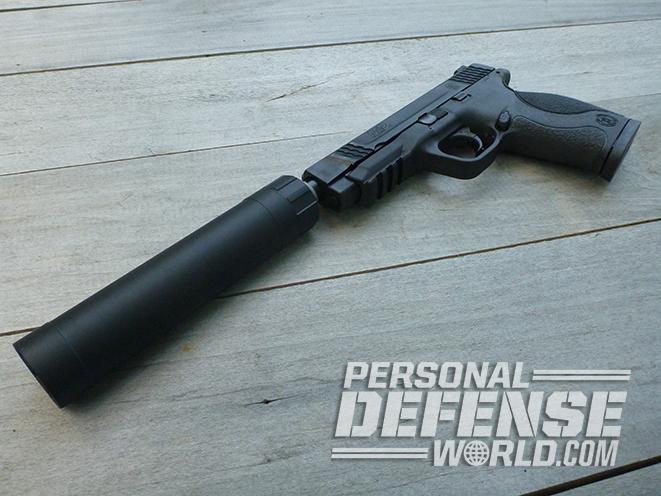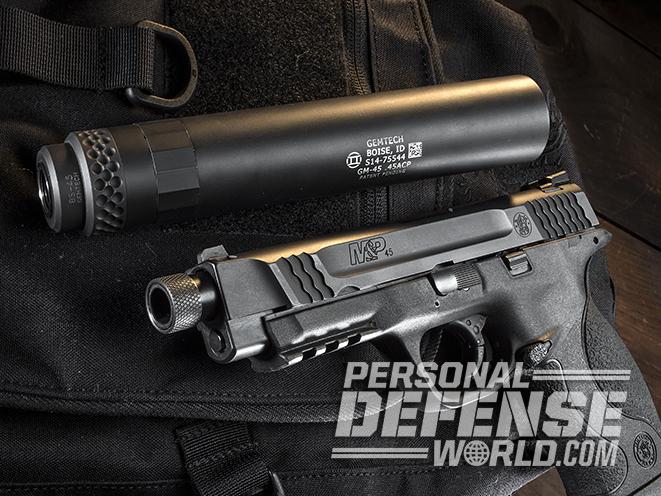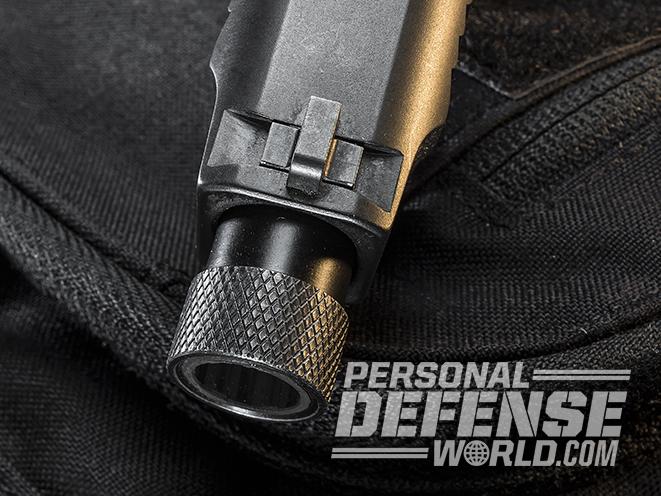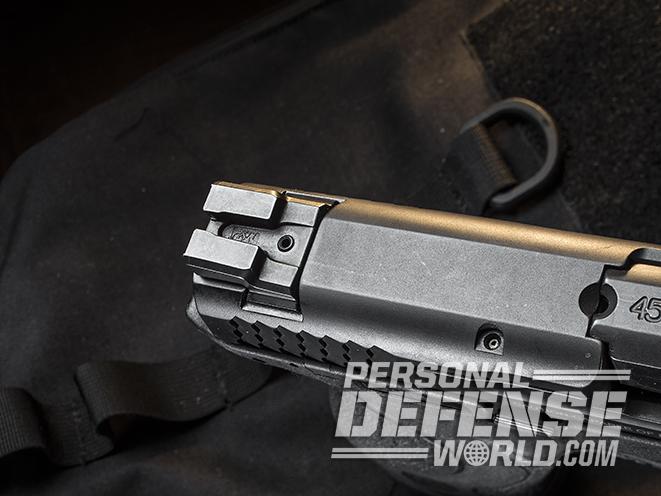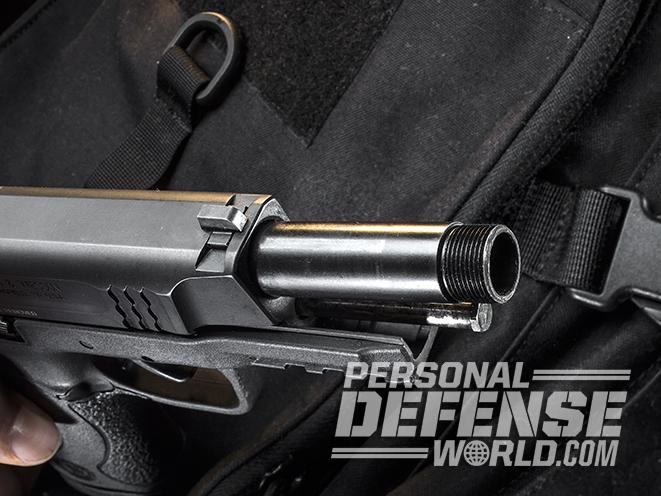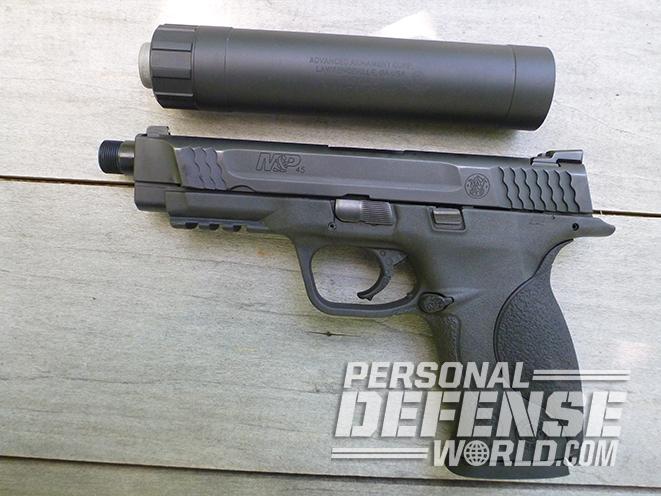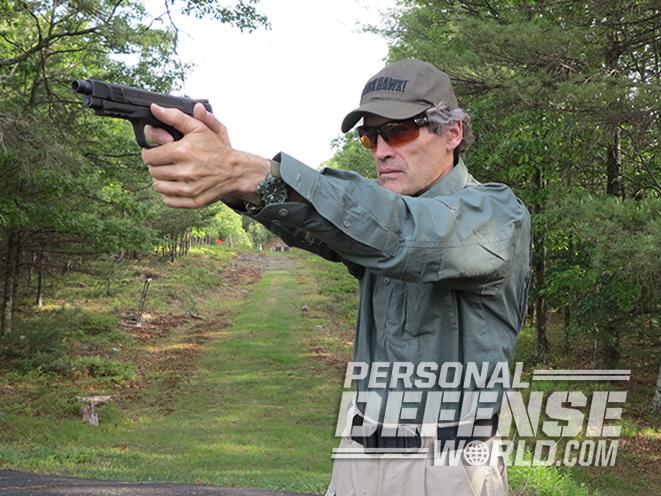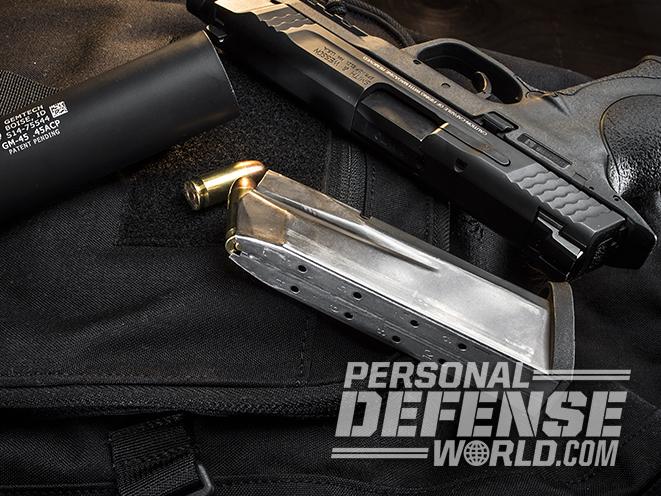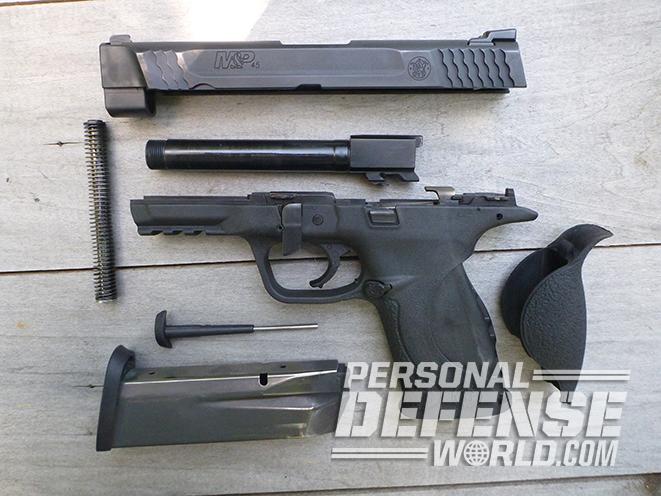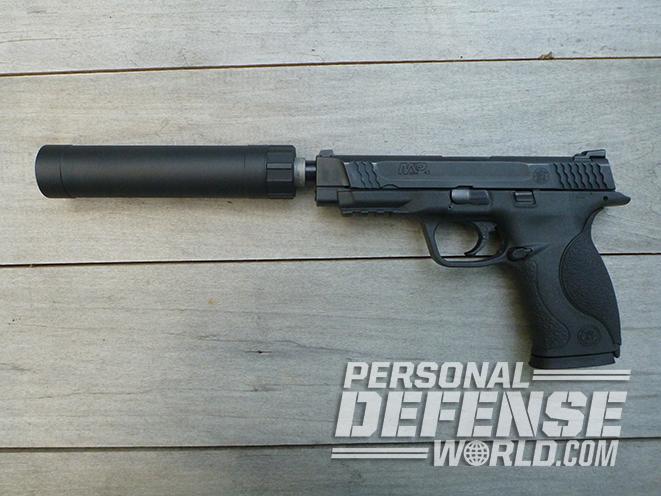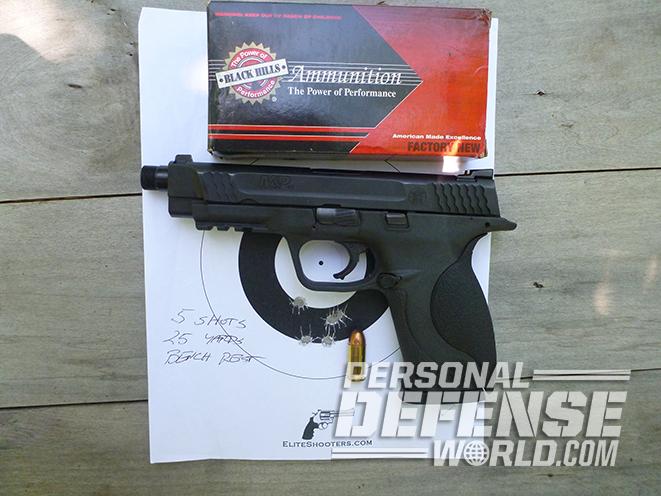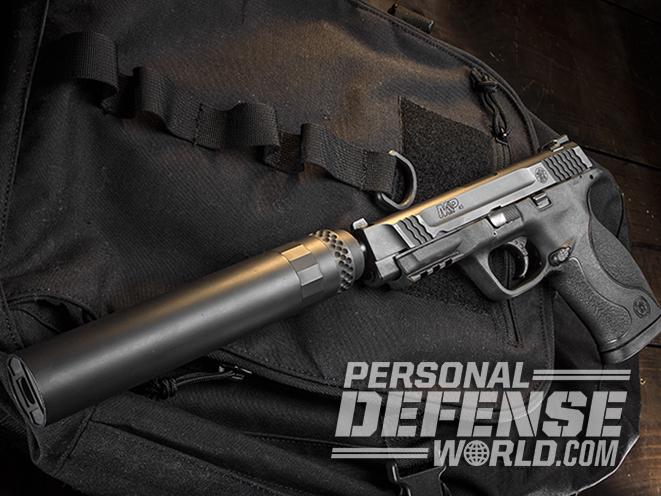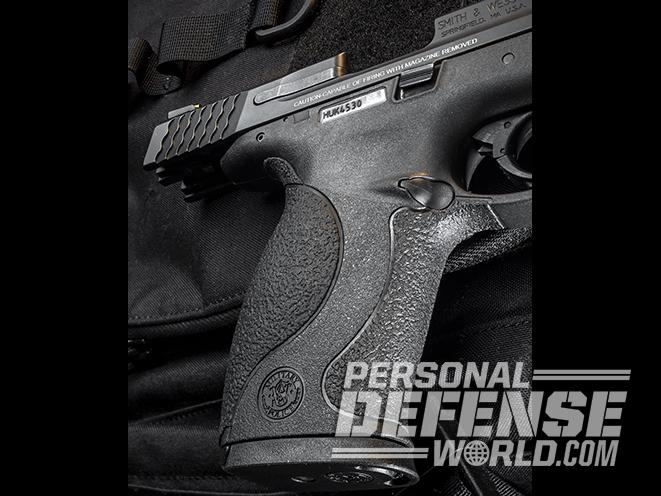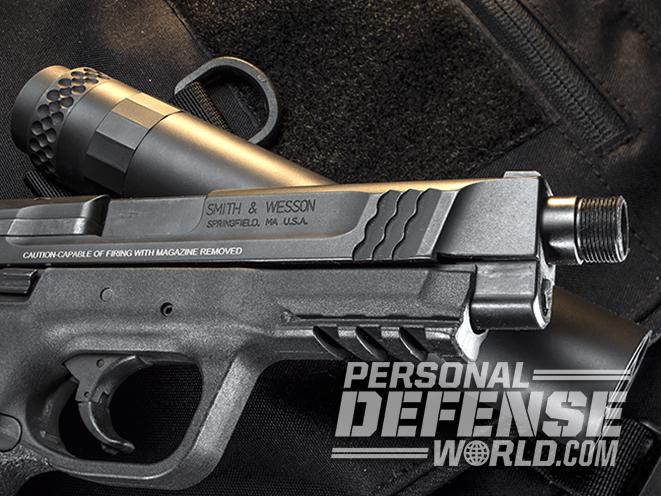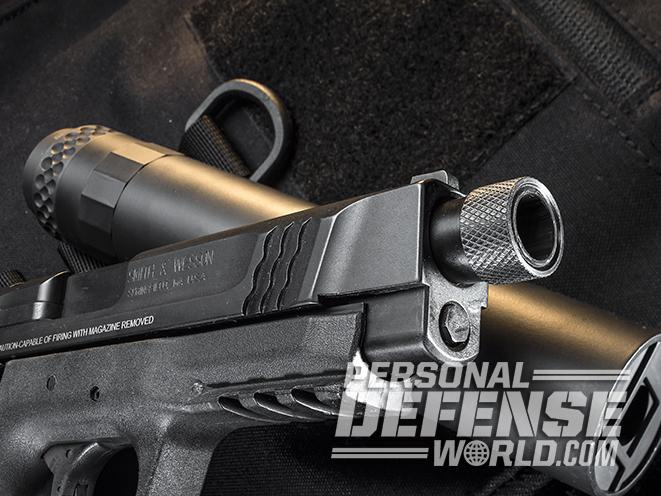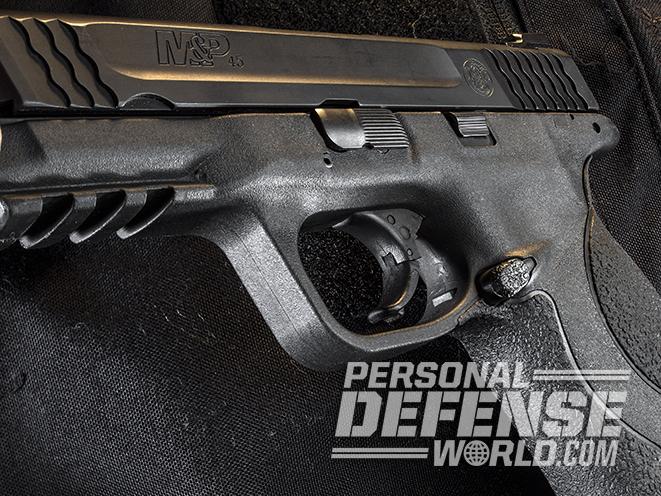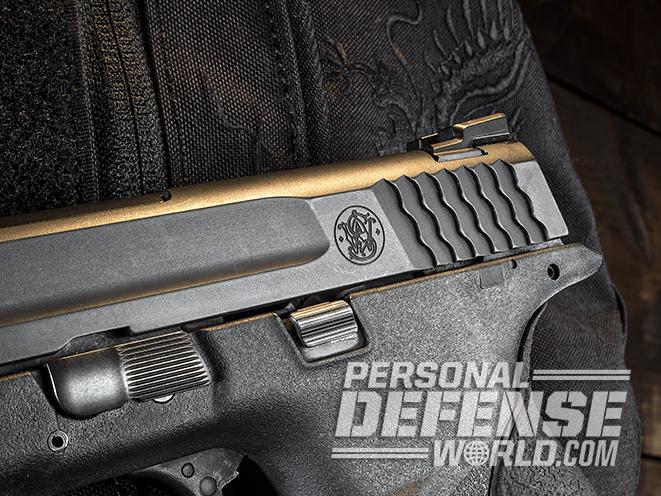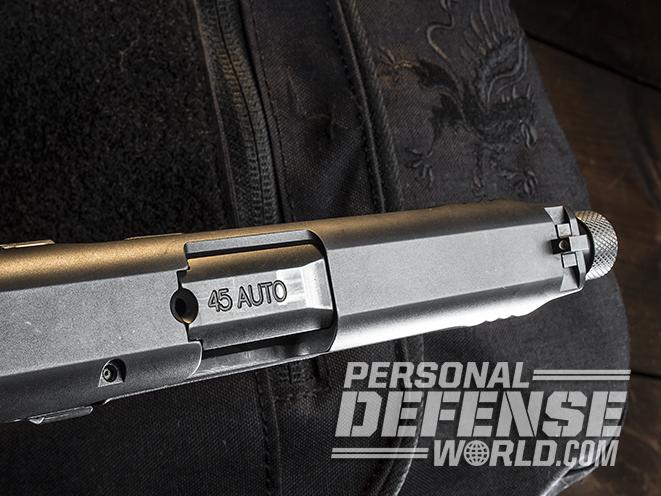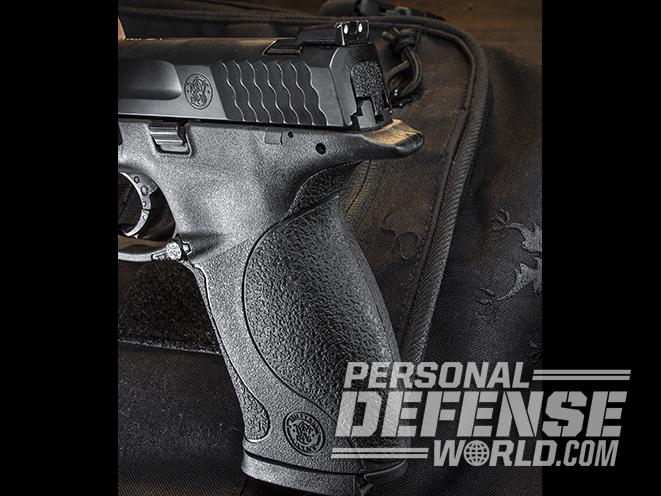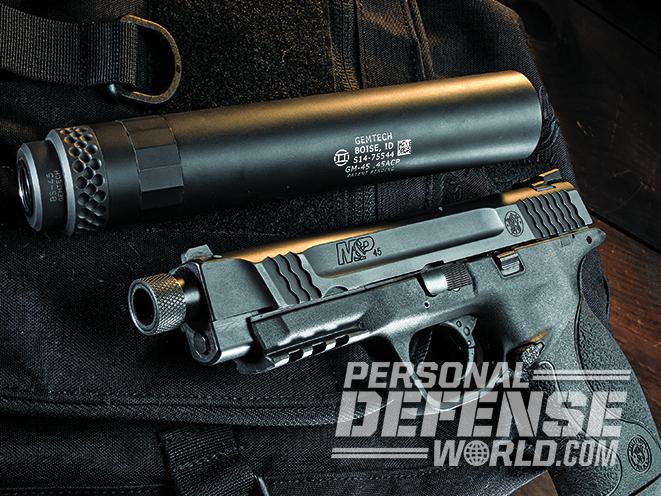The M&P series is the flagship of Smith & Wesson’s handgun line, with models in four sizes (long-slide, full-sized, compact, subcompact) and in several calibers: .22 LR, 9mm, .40 S&W, .357 SIG and .45 ACP. The M&P pistols evolved from the Sigma series, which the company designed to compete with other polymer-framed pistols on the market. For several reasons, however, the Sigma never was a big success. In contrast, the M&P pistols are engineered differently and are essentially much better. Though both models were originally made simultaneously, the more durable and full-featured M&P prevailed while the Sigma was discontinued.
Firearms equipped from the factory with threaded barrels to mount sound suppressors have become much more prevalent in recent years, and though the trend seems to have taken hold more so with rifles, suppressor-ready pistols like the M&P45 Threaded Barrel Kit are now widely available. The Threaded Barrel Kit in the model name refers to the inclusion of an extra threaded barrel (with a thread protector) in addition to a standard barrel. The kit adds $120 to the MSRP over the base model, which saves you $55 over purchasing a separate barrel from Smith & Wesson.
Versatile M&P45

The M&P45 uses a striker-fired trigger system similar in mechanics to other polymer-framed pistols. The striker is partially cocked by the operation of the slide, and pressing the trigger fully cocks and releases it to fire the pistol. This is essentially a double-action design since the action of the trigger both cocks and releases the striker. The M&P45 also has a trigger designed to be “drop safe” since it only moves rearward if depressed and pivoted in such a way that it can move rearward. The M&P45 design, however, departs significantly from polymer-framed handguns in all other respects. And though the M&P45 Threaded Barrel Kit does not come with a manual thumb safety, Smith & Wesson offers other M&Ps with them.
Advertisement — Continue Reading Below
- RELATED STORY: Gun Test – Wringing Out the Smith & Wesson M&P9 M2.0
The full-sized M&P45 shares certain features used in the M&P CORE and Shield designs. These pistols all use a stainless steel chassis with integral slide rails instead of molded-in inserts to stiffen the polymer frame. Also, the action parts (e.g., the slide lock levers) and locking block are also directly connected to this chassis. This steel-to-steel connection is distinct from many other polymer-framed designs that rely on parts independently molded into a plastic frame rather than connected in one unit.
The use of steel in the M&P’s sights and recoil spring guide rods, for instance, are two elements of this pistol’s more durable design compared to pistols that use plastic. The M&P45 also has a Melonite finish on the slide, sights, extractor and barrel—inside and out—which has proven to be a very durable finish.
Field-stripping the M&P45 is simple but requires an additional step—pushing the sear downward so that is does not engage the striker and keep the slide from being removed. After removing the magazine and ensuring the chamber is empty, lock the slide to the rear and look downward, into the open action, to locate a small metal tab painted yellow. This tab must be pushed downward, which presses the sear out of alignment with the rear of the striker. Now rotate the takedown lever and pull the slide assembly forward, off the frame. Though the tab is small and seems flimsy, it has no function other than to allow disassembly: There’s no need to be concerned about breakage rendering your pistol inoperable in a gunfight.
Advertisement — Continue Reading Below
The M&P45 has a very well-designed grip that came about from an extensive research and development investment made on Smith & Wesson’s part. Smith & Wesson’s engineers determined that an 18-degree grip angle was ideal for instinctively pointing a pistol, and subsequently incorporated it into all of the full-sized and compact M&P series pistols.
The M&P45’s grip panel can be changed to fit the shooter’s hand by simply removing a pin from the base of the frame and then removing the grip panel. While changing backstraps alone will adjust the trigger reach, it won’t address palm fit, which is a major factor in comfort. With the M&P45, the three grip panels add to the trigger reach and also adjust the grip’s girth. This is the only pistol where the user can adjust side thickness and backstrap width that I know of other than HK’s P30, HK45 and VP series pistols. Smith & Wesson also got it right with the contour of the grip side panels. They fit the curve of your hand rather than being flat-sided.
Changing the size of the grip panel improves comfort, but the more important aspect is to find a panel that positions your finger on the trigger in a way that your trigger stroke goes straight to the rear without disturbing the sights. Find out what size works best by dry-firing using all three grips, and don’t assume that the panel that feels the best is the best for trigger control. A laser-aiming device like the Streamlight TLR-2 HL I use works well for this exercise because you can see exactly how much the pistol moves as you work the trigger. When you find the right one, be mindful that there may be tradeoffs between choosing the best trigger stroke and how easily you can access the magazine release and slide lock lever.
Advertisement — Continue Reading Below
Range Ti-RANT

To measure the M&P45 Threaded Barrel Kit’s inherent accuracy, I used the standard, non-threaded 4.5-inch barrel and a rest to fire three 230-grain FMJ loads from Black Hills, Remington and Winchester. I also ran the pistol with the threaded 5.18-inch barrel and an Advanced Armament Corporation Ti-RANT 45S suppressor. I tested the pistol’s reliability using several brands of ammo, including those with hollow-point bullets, and there were no stoppages or malfunctions with any of the loads, with or without the sound suppressor.
All three FMJ loads shot accurately, with the smallest five-shot group of 1.4 inches being delivered with the Black Hills ammo, followed by the Remington and Winchester loads at 1.7 and 2.5 inches, respectively. The Black Hills load was match grade, as the results reflected. Also, this is a full-power load, so it had a 43-fps higher average velocity than the more economical Winchester-brand practice ammo.
The M&P45’s trigger pull weighed just over 7 pounds, according to my Lyman digital trigger pull gauge. Its take-up and creep were typical of many striker-fired pistols where the striker is partially cocked by the cycling of the slide and fully cocked and released by action of the trigger.
Advertisement — Continue Reading Below
You might be wondering how much of an uptick in velocity to expect from using the threaded 5.18-inch barrel over the standard 4.5-inch barrel. I conducted an informal test with the Remington and Winchester loads. The results showed that the average increase in velocity from the extra barrel length was only 6 fps for the Remington load and 39 fps for the Winchester. The increase in velocity was greater, however, when comparing the velocity with the standard barrel to the threaded barrel with the AAC Ti-RANT 45S suppressor in place. Here the increase was 43 and 97 fps for the Remington and Winchester loads, respectively. This increase, as expected, results from the bullet losing frictional contact with the barrel but still accelerating from the forces of gas pressure within the suppressor.
The AAC Ti-RANT 45S is the shorter version of the original Ti-RANT 45. I own both versions but prefer the shorter model because it usually provides less of a point-of-impact (POI) shift. The POI shift is the change in the place a bullet strikes the target when a suppressor is mounted to the firearm. With the M&P45, the POI shifted directly downward by about 4 to 5 inches at 20 yards with the suppressor attached.
The exact shift was difficult to quantify because the sights on the M&P45 are low profile, and it’s hard to obtain a good sight picture because the sound suppressor gets in the way. High-profile sights would rectify this, but even after an exhaustive search, I could not locate any that could be installed without additional machining on the slide. One solution is to remove both the front and rear sights using the MGW Sight Pro adjustment tool and install an optical sight at the rear, like the Leupold DeltaPoint. I have used the MGW Sight Pro tool for replacing and drifting dovetail-mounted sights on several pistols and find it does the job without damaging the slide and with a certain degree of precision.
Advertisement — Continue Reading Below
Quiet Riot
The M&P45 Threaded Barrel Kit comes with a lifetime warranty and offers additional features, very good durability and a very good grip. All of this adds up to make it competitive with other polymer-framed pistols. Though suppressor-height sights would be a big enhancement for this pistol, the additional threaded barrel offers a significant cost savings.
Caliber: .45 ACP
Barrels: 4.5 and 5.18 inches
Advertisement — Continue Reading Below
OA Length: 8 inches
Weight: 29.6 ounces (empty)
Grip: Polymer
Advertisement — Continue Reading Below
Sights: Three-dot
Action: Striker-fired
Finish: Matte black
Advertisement — Continue Reading Below
Capacity: 10+1
MSRP: $719
For more, visit smith-wesson.com or call 800-331-0852.
This article was originally published in “Combat Handguns” May/June 2017. To order a copy, visit outdoorgroupstore.com.
